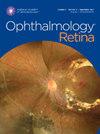Endophthalmitis Incidence after Intravitreal Injection of Anti-VEGF Agents with Povidone-Iodine versus Aqueous Chlorhexidine Antisepsis
IF 5.7
Q1 OPHTHALMOLOGY
引用次数: 0
Abstract
Purpose
To evaluate the incidence of postinjection endophthalmitis (PIE) after intravitreal injection (IVI) of anti-VEGF agents in eyes prepared with topical 5% povidone-iodine (PI) or 0.05% aqueous chlorhexidine (AqCHX) as antisepsis.
Design
Retrospective, single-center, comparative cohort study.
Participants
Individuals who received ≥1 intravitreal anti-VEGF injection with use of PI or AqCHX as antisepsis.
Methods
For all patients receiving intravitreal anti-VEGF injections at Austin Retina Associates between March 1, 2015 and November 1, 2023, all injections and cases of suspected PIE were identified with billing codes and confirmed with review of electronic medical record data. Eyes that presented after injection with pain or decreased vision warranting treatment with intravitreal antibiotics were considered suspected PIE cases. Eyes were grouped based on preparation with PI or AqCHX.
Main Outcome Measures
The primary outcomes were incidence of suspected and culture-positive PIE and visual acuity (VA) at 3 months postendophthalmitis.
Results
A total of 302 474 IVIs were administered during the study period. Within the PI group, 59 cases of suspected PIE occurred after 267 190 injections (0.022%; 1 in 4529 injections) compared with 5 cases after 35 284 injections (0.014%; 1 in 7057 injections) in the AqCHX group (P = 0.34). For the PI group, there were 10 culture-positive PIE cases (0.0037%, 1 in 26 719 injections) compared with 0 cases in the AqCHX group (P = 0.25). At 3 months postinfection, average VA in the PI group was 0.97 (∼20/200) and 1.4 (∼20/500) in the AqCHX group (P = 0.41). When controlling for prefilled syringe status, there was no difference in rates of PIE between antisepsis groups (P = 0.23).
Conclusions
The incidence of endophthalmitis after IVI is low, with no difference in the rates of infection with eyes prepared with topical PI compared with AqCHX. Topical AqCHX has similar efficacy to PI for the prevention of endophthalmitis after IVI.
Financial Disclosure(s)
Proprietary or commercial disclosure may be found in the Footnotes and Disclosures at the end of this article.
玻璃体内注射抗vegf药物与聚维酮碘与氯己定水消毒后眼内炎的发生率。
目的:观察用5%聚维酮碘(PI)或0.05%氯己定(AqCHX)配制的抗血管内皮生长因子(VEGF)药物玻璃体腔内注射后眼内炎(PIE)的发生率。设计:回顾性、单中心、比较队列研究参与者:接受至少一次玻璃体内抗vegf注射并使用PI或AqCHX作为防腐剂的个体。方法:对2015年3月1日至2023年11月1日在Austin Retina Associates接受玻璃体内抗vegf注射的所有患者,使用账单代码识别所有注射和疑似PIE病例,并通过审查电子病历数据进行确认。注射后出现疼痛和/或视力下降,需要玻璃体内抗生素治疗的眼睛被认为是疑似PIE病例。根据PI或AqCHX的制备方法对眼进行分组。主要指标:主要指标为眼内炎后3个月疑似及培养阳性PIE的发生率及视力。结果:在研究期间共进行了302,474次玻璃体内注射。在PI组中,267,190次注射后出现59例疑似PIE (0.022%;4529次注射中有1例),而35284次注射中有5例(0.014%;1 / 7057) (p=0.34)。PI组有10例PIE培养阳性(0.0037%,1 / 26,719次注射),AqCHX组为0例(p=0.25)。感染后3个月,PI组的平均视力为0.97 (~ 20/200),AqCHX组的平均视力为1.4 (~ 20/500)(p=0.41)。在控制预充注射器状态时,两组间PIE发生率无差异(p=0.23)。结论:玻璃体内注射后眼内炎的发生率较低,与AqCHX相比,外用PI制备的眼睛感染发生率无差异。外用AqCHX是一种安全有效的替代PI的防腐剂,用于预防玻璃体内注射后的眼内炎。
本文章由计算机程序翻译,如有差异,请以英文原文为准。
求助全文
约1分钟内获得全文
求助全文

 求助内容:
求助内容: 应助结果提醒方式:
应助结果提醒方式:


